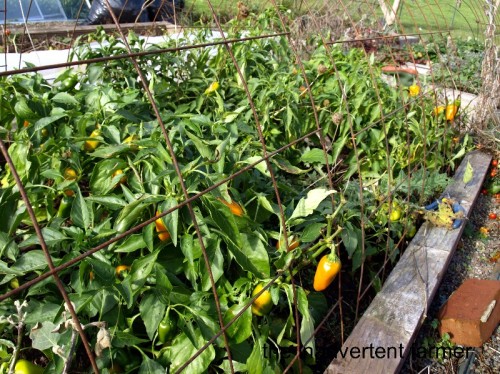
So many of us are working our way toward a more self-sufficient lifestyle. With that in mind we wanted to share some general guidelines of what to plan for on a monthly basis. Whether you’re a gardener, a beekeeper, a forager, or you keep animals, hopefully our monthly guides will help you plan ahead for the month. Depending on your exact climate you may find you need to adjust your schedule plus or minus two weeks or more.
September is the time of year that we begin to feel the crisp air of Autumn moving in. Evenings are chilly even though afternoons can be very warm. Autumn fruits are beginning to ripen and the thought of spiced cider seem to warm spirits. September is the time for clear skies, bonfires, and wrapping up Summer’s last duties. It’s a big month for tidying up the garden, so hold back those nesting instincts for another month and enjoy the clear, bright skies and cool air.
Indoors
- Be sure your root cellar is ready to accept produce. If you’re using boxes with sand or sawdust make sure they’re clean, sanitized, dry, and critter-proof.
- Be sure your deep freezer is cleaned out. Remove past date items and make room for Fall’s harvests.
- Complete any chores that require you to keep your windows open. Painting, cleaning carpeting, cleaning ovens and so forth should be finished before it gets cold during the daytime.
- Wash items that require long, outdoor drying times or those that can only be taken care of outside. Litter boxes, garbage pails, sanitary pails, area rugs, pillows, and so forth should be washed while the remaining warm air can help with drying.
- Air out winter clothing, blanketing, and other items you may have kept in storage over the warm seasons.
- Be sure your fireplaces are in working order before you need them. Check that wood stacks are staying dry and are easy to get to.
- Check fire and carbon monoxide alarms before lighting up your furnace or fireplace for the first time.
Outdoors
- Be sure your cold frames and greenhouses are airtight and ready to go for the cooler nights. Daytime temperatures can become very hot in these locations, so be sure to open and close windows as needed. Consider investing in a self-opening elbow for your windows. They can save many trips back and forth throughout this fickle weather.
- Leaves will begin to fall soon. Make sure your compost bins or piles are ready to accept fresh materials.
- Give one last inspection to your windows and doors in case you didn’t get to them last month. Be sure that they’re air tight and sealed before cold weather really sets in.
- Change air filters on furnace.
Garden
- Herbs can be cut and dried for saving. Remember to bring some in to create a window garden for a fresh Winter source of Summer’s flavors.
- Seed saving and dead-heading can begin once again. Remember to allow some of your perennial seeds to self-sow by leaving only a few “dead heads” or by sprinkling some seed. Save some seed for finches (they adore Echinacea) and other seed lovers. Too many dead heads can lead to disease.
- Don’t prune rose hips yet if you plan on saving them for jellies or medicinal purposes.
- Bring in your more sensitive plants as the nights get cooler. Stevia, ginger, and other tropicals don’t like colder weather. Many other herbs can stay outside until the first frosts.
- It’s a good time to take cuttings of woody plants and shrubs.
- If you’re planning on dividing or planting bulbs for next year now is the time to do it! Also divide shrubby herbs like lemon balm, oregano, mints, sage, fennel, tansy, and marjoram.
- Harvest frost-sensitive plants and Winter keepers before your first frosts. Put green tomatoes in paper bags to ripen slowly and use later. Potatoes, onions, and other keepers should be kept in a cool dark place.
- Cut back dying foliage. Burn diseased foliage as soon as possible. Healthy plants can be put into compost as long as they are seed-free. As fun as it is to have a surprise potato plant sprout from the compost bin, you don’t want those plants (or weeds) to use up all that energy you’ve been saving for your garden!
- Green manures for cool seasons can be sown.
- Strawberry runners should be rooted and transplanted by the end of the month.
- Shrubs and trees, fruiting or not, can be planted now that the cool weather is setting in. Fall is an excellent time for transplants since most trees are storing or spending energy in and on their root systems.
- Speaking of fruiting trees and plants, remove mulch and prune those that need it.
Animals
- Put in your orders for Winter supplies of food, straw, and hay.
- Give a good cleaning to coops and barns to try to avoid housing mice and other small, unwanted critters.
- September and October are good months for building. If you’re planning on adding to the animal family next year, consider any outdoor units that may need to be added.
- Repair coops, lean-tos, stables, and other shelters before cold weather sets in. Keep your animals happy and warm at night.
- Start considering mating sheep and goats for Spring kids and lambs. They’re both on about a 150 gestation cycle so a late month conception would lead to a late February birth.
- With birth also comes death. Start planning for cold weather slaughters. Animals are best harvested when the weather is below 40 degrees. The cooler the better, especially if you’re inexperienced or have a lot of work to do. Research your product and begin gathering needed items. Mise en place. Have stock pots, seasonings, casings, sharpening stones, recipes, packaging, and tools all ready prior to harvesting.
Wildlife
- Continue to feed your hummingbirds and other songbirds. Migrations will begin this month and you may have a few unusual visitors to your feeders.
- Like us humans, wild critters are beginning to stock away for the colder seasons. Allow seed heads to remain on natives and refrain from too much tidying up of acorns and other nuts, seeds, and berries. Skunks, squirrels, rabbits, birds, and other small animals need to fatten up to keep warm through the Winter.



 To better explain myself, I should start at the beginning. Probably any gardener wants a greenhouse, and I’m no exception. We started making plans to build a greenhouse for mesclun sales the year our daughter was born. We wanted to add an additional income stream on our farm, that would not take up pasture or require cutting down any trees. Building a 30′ x 72′ commercial style greenhouse in our “compound” area seemed like a perfect fit.
To better explain myself, I should start at the beginning. Probably any gardener wants a greenhouse, and I’m no exception. We started making plans to build a greenhouse for mesclun sales the year our daughter was born. We wanted to add an additional income stream on our farm, that would not take up pasture or require cutting down any trees. Building a 30′ x 72′ commercial style greenhouse in our “compound” area seemed like a perfect fit.










